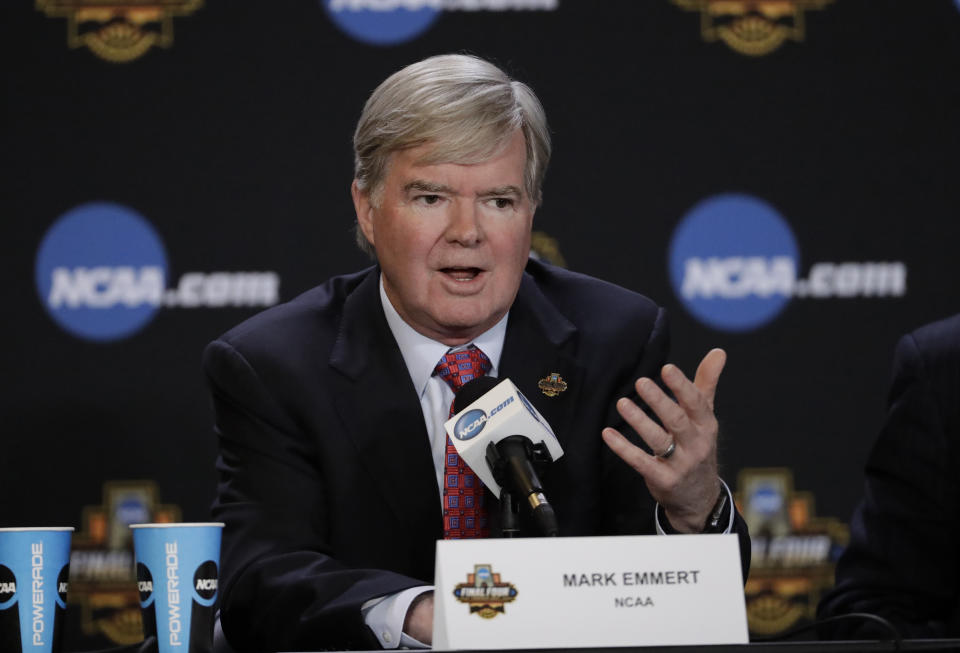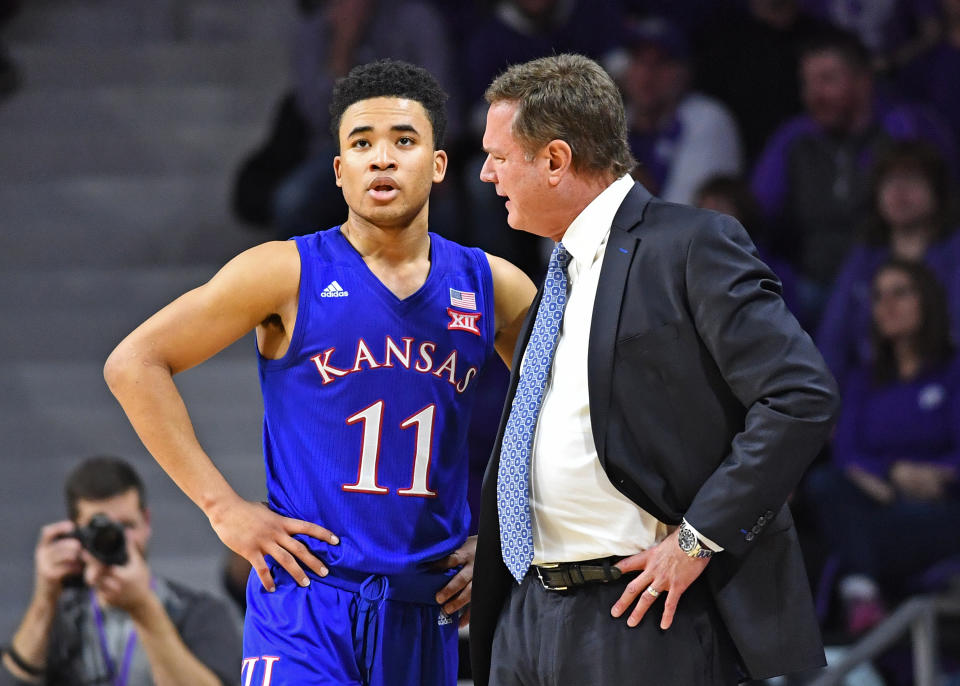California is forcing the NCAA's hand — and no, the college sports world isn’t going to end
On Monday, California Gov. Gavin Newsom signed Senate Bill 206, which makes it illegal, starting in 2023, for the NCAA to prevent any in-state athlete from profiting off their name, image or likeness.
This doesn’t mean schools will start “paying the players.” It means that a player will be allowed to pick up endorsements, sponsorships or employment based on competing for the school.
That can mean everything from a likely No. 1 NBA draft pick grabbing a Nike deal, to the star quarterback getting a state-wide television commercial, to a national champion wrestler signing autographs at a local car dealership, to a softball player going back to her hometown and starting a summer camp training kids.
What it doesn’t mean is the destruction of college athletics, like so many critics are howling.
We went through this in the 1980s when the International Olympic Committee got rid of its “amateurism” rules.
Things like the men’s basketball Dream Team and the U.S. women’s national soccer team proved to be incredibly popular. The fact that Michael Phelps and Usain Bolt could compete in multiple Olympics increased the popularity of the Games.
Meanwhile, the governing bodies (IOC, USOC, USA Gymnastics) or media companies (NBC) that used to have a monopoly on corporations attaching its brand to the Olympics, still had plenty of money to operate.
The free market made everything better. All the critics were wrong.
This will repeat with SB 206, as well as similar laws from other states that will likely soon follow. (Newsom predicts at least 10 are coming.)

It’s worth noting, however, that the NCAA’s recent success at beating back challengers in federal court may mean that SB 206 never survives. The NCAA may be forced into its own plan, which may prove better than the one politicians drew up. We’ll see.
In the interim, there is hysteria, such as wondering if allowing athletes to sign endorsement deals just means that Alabama will land all the best football recruits because they have the boosters who will bid $1 million per recruit to be a spokesman for whatever their business is.
That probably won’t happen.
First off, the NCAA’s “level playing field” doesn’t actually exist. The more money schools spend, the more coaches they employ, the bigger the stadiums they build, the better recruits they get. The boosters are already buying the recruits (and that’s not even speaking to the non-NCAA compliant payments).
Consider this: In the past three years in football recruiting there have been 97 players ranked as 5-star recruits by Rivals.com. Five schools (Alabama, Clemson, Georgia, Ohio State and LSU) signed a combined 55 of them, leaving just 42 for the remaining 125 FBS schools. Five schools got nearly 57 percent of the best players.
The current top five teams in the weekly AP poll? No. 1. Alabama. 2. Clemson. 3. Georgia. 4. Ohio State. 5. LSU.
What a coincidence.
In this case, even if the rich schools did continue their dominance and hoard the best recruits, what changes? Well, other than the money wouldn’t go to associate deputy athletic director salaries and construction contractors for unnecessarily opulent locker rooms, but, instead, directly to players and their families.
And where’s the problem there?
This actually may level the playing field. Right now Baylor, let alone Boise State, rarely beats Alabama for a recruit. By bringing everything above board, who knows? Isn’t there more money to be made being a three-year starter in a city such as Waco or Boise, where you are the undeniable star, rather than just another cog in the huge machine of the Crimson Tide or playing for USC in the crowded Los Angeles market?
Do you realize how popular Bryce Petty (Baylor) or Kellen Moore (Boise) still are in their college towns? Would they have been at Alabama? Seems like more schools, not fewer, would have a recruiting pitch.
Does Alabama have crazy boosters that will throw down stupid money? Yes. But every school has crazy boosters that will throw down stupid money. Have you seen these weight rooms?
In the end, a loose salary cap will set itself. It may seem like every car dealer in the SEC will be offering up half-million dollar deals, but reality won’t work that way. Business is business. You can only sell so many F-150s. Trust the free market.
As for basketball, anyone who denies that Nike, Adidas and Under Armour aren’t already doing this has been asleep for the past two years — if not two decades. All those kids from the Nike grassroots system aren’t going to Duke by accident. Nor do the Adidas guys just coincidentally love the idea of living in Lawrence, Kansas.

Put it out in the open and let all businesses, not just the shoe business, have a crack at influencing recruits, and the sport could become a far more fair place to compete.
This also allows the special players to profit off their own talents and hard work. This isn’t 1975 when college sports was truly “the name on the front of the jersey, not the back.” Zion Williamson had 1.7 million Instagram followers before he even got to Duke. Where the harm in him profiting off of that?
Perhaps best of all is the impact this could have on athletes outside of football and basketball. No, the numbers may not be as big, but certainly a women’s basketball player at UConn or a gymnast at Oklahoma or a hockey player at Minnesota Duluth could have the potential to gain local endorsements. Or they can market themselves through YouTube channels and social media, like any other student (or American).
Everything is a niche in America, and each sport has its young stars.
If you earn it, you earn it. It’s not the college’s money.
Ah, but of course, panicked college administrators are claiming it is their money. The reasoning is that any deal where a would-be booster gives money directly to an athlete means that money won’t be coming to the athletic department coffers for them to use. Like how Phelps getting a deal hawking Subway sandwiches meant Subway cut out the middle man and didn’t include USA Swimming, like the old days.
They are even grandstanding and claiming this is anti-woman.
“[The bill] will likely reduce resources and opportunities for student-athletes in Olympic sports and have a negative disparate impact on female student-athletes,” the Pac-12 said in a statement.
This is painfully ridiculous. Start with this, Pac-12 schools have billions in operating expenses and cash on hand to easily afford, if it so chooses, to field teams in dozens and dozens of sports. Stanford has its $24.7 billion endowment, after all. A dozen softball scholarships isn’t going to break them.
What the league is saying is that it doesn’t value those sports or those athletes. Essentially, Stanford, or USC or Arizona State, doesn’t want to pay for a softball team. Yes, they have the money to, but they are acknowledging that it doesn’t make much sense for a university to fund.
As such, they would stop (or lower) the funding unless they can continue to have football and men’s basketball players to pay for them based on those athletes not getting their own endorsement deals. It’s like a forced donation to the athletic department.
If those players get their money, the schools are saying, then they shut down the Olympic sports. But if the schools don’t care about those sports, why should the football and basketball stars care? Why is that their obligation?
Really, though, if the Pac-12, or anyone else, really cared about scholarship opportunities for Olympic sports (men or women), then they would have worked over the years to increase the NCAA limits on the amount of full rides that can be offered. The more scholarships the better, right?
College sports have been booming of late, with television money filling and refilling the coffers. Yet there has been very little movement on increasing the number of athletes (male or female) who receive scholarships.
Almost all teams run at a deficiency. It’s not uncommon for a women’s soccer team to have 30 players on the roster. Yet the NCAA allows just 14 scholarships, forcing the deals to be divided up. Same with baseball or track or swimming or so on.
Instead the administrators just spent all the new billions on themselves. In 2010-11 — just this decade — the University of Michigan employed 253 people (coaches and administrators) at an average salary of $73,382, according to school records. By 2018-19, it was up to 388 and $101,137. So almost no new scholarships for the players and their families, but 53.3 percent more employees are making 37.8 percent more money.
And college administrators want to claim they care about Olympic sports and female athletes?
When the arguments go that off-kilter and that far from reality, you know one side has nothing to stand on.
That was the IOC in the 1980s. That’s the NCAA today.
Whatever happens with SB 206 and name, image and likeness, the world will survive. Doomsayers be damned.
More from Yahoo Sports:

